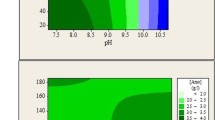Abstract
The liquid–liquid extraction of protein from buffered aqueous phases using reverse micelles (RM) has been extensively researched from a fundamental point of view. However, very little effort has been expended at scaling up this process for the extraction of real fermentation broth. When real broths are used with reverse micellar phases there are major problems with emulsion formation. In this study the effect of a variety of demulsifiers on lysozyme extraction was evaluated in terms of their influence on the separating properties of the emulsion, water content (W o ), and, extraction yield and kinetics from both buffer and hen egg white. In addition, the use of a low shear contactor (a Graesser or `raining bucket') was assessed in terms of its suitability as a RM contactor. It was found that most of the demulsifiers reduced the settling time of the emulsion, and enhanced the yield and kinetics of lysozyme extraction from hen egg white. It was hypothesised that this was due to the demulsifier displacing the lysozyme from the interface and preventing the protein unfolding and precipitating. This effect was found to depend on both the generic type of demulsifier, and its concentration.
Similar content being viewed by others
References
Al-Hemiri AA and Kareem A (1990) Dropsize distribution in a Graesser contactor. Can. J. Chem. Eng. 68: 569-576.
Alves JRS, Fonseca LP, Ramalho MT and Cabral JMS (1995) Separation and purification of penicillin acylase from E. coli using AOT reversed micelles. Biotechnol. Tech. 9: 265-270.
Cardoso M, Viegas R and Crespo J (1999) Extraction and reextraction of phenylalanine by cationic reversed micelles in hollow fibre contactors. J. Membr. Sci. 156: 303-319.
Carneiro-da-Cunha MG, Aires-Barros MR, Tambourgi EB and Cabral JMS (1994) Recovery of a recombinant cutinase with reverse micelles in a continuous perforated rotating disc contactor. Biotechnol. Tech. 8: 413-418.
Coimbra JDR, Thommes J and Kula MR (1994) Continuous separation of whey proteins with an aqueous 2-phase system in a Graesser contactor. J. Chrom. A. 668: 85-94.
Coimbra JDR, Thommes J, Meirelles AJ and Kula MR (1995) Performance of a Graesser contactor in the continuous extraction of whey proteins: mixing, mass transfer and efficiency. Bioseparation 5: 259-268.
Dahuron L and Cussler E (1988) Protein extractions with hollow fibres. AIChE J. 34: 130-136.
Dekker M, Koenen P and van't Riet K (1991) Reversed micellar membrane-extraction of enzymes. Trans. IChemE. 69(C): 54-58.
Han D, Lee S and Hong W (1994) Separation of intracellular proteins from Candida utilus using reverse micelles in a spray column. Biotechnol. Tech. 8: 105-110.
Jarudilokkul S, Poppenborg LH and Stuckey DC (1998) Backward extraction of reverse micellar encapsulated proteins using a counterionic surfactant. Biotechnol. Bioeng. 62: 593-601.
Jarudilokkul S (2000) Protein extraction using reverse micelles: selectivity, activity recovery, and contactor design. Ph.D. thesis, University of London. UK.
Krei GA and Hustedt H (1992). Extraction of enzyme by reverse micelles. Chem. Eng. Sci. 47: 99-111.
Lennie S and Halling P (1990) Cause of emulsion formation during solvent extraction of fermentation broths and its reduction by surfactants. Biotechnol Bioeng. 35: 948-950.
Lissant K (1983) Demulsification: Industrial Application. Marcel Dekker Inc., New York and Basel.
Meagher RJ and Hatton TA (1998) Enthalpy measurements in aqueous SDS/DTAB solutions using isothermal titration microcalorimetry. Langmuir. 14: 4081-4087.
Mackie AR, Gunning P, Wilde PJ and Morris V (1999) Oroogenic displacement of protein from the air/water interface by competitive adsorption. J. Colloid Interface Sci. 210: 157-166.
Naoe K, Shintaku Y, Mawatari Y, Kawagoe M and Imai M (1995) Novel function of Guanidine hydrochloride in reverse micellar extraction of lysozyme from chicken egg white. Biotechnol Bioeng. 48: 333-340.
Naoe K, Imai M and Shimizu M (1996) Optimal amphiphile concentration for lysozyme extraction using reverse micelles. Trans IChemE Part C. 74: 163-170.
Nishii Y, Nii S, Takahashi K and Takeuchi H (1999) Extraction of proteins by reversed micellar solution in a packed column. J. Chem. Eng. Jpn. 32: 211-216.
Nishiki T, Sato I and Kataoka T (1998) Mass transfer characterization in forward and back extraction of lysozyme by AOT-isootane reverse micelles across a flat liquid-liquid interface. Biochem. Eng. J. 1: 91-97.
Plucinski P and Nitsch W (1988) The two phase kinetics of the solubilization in reverse micelles, in Proceedings of the 7th International Symposium on Surfactants in Solution. Ottawa, Canada.
Plucinski P and Nitsch W (1989) Two-phase kinetics of the solubilization in reverse micelles extraction of lysozyme. Phys. Chem. 93: 994-997.
Rahaman RS, Chee JY, Cabral JMS and Hatton TA (1988) Recovery of an extracellular alkaline protease from whole fermentation broth using reversed micelles. Biotechnol. Prog. 4: 218-223.
Reid V, Longman G and Heinerth E (1967) Determination of anionic active detergents by two-phase titration. Tenside. 4: 292-304.
Sheik AR, Ingham J and Hanson C (1972) Axial mixing in a Graesser raining bucket liquid-liquid contactor. Trans. Inst. Cem. Eng. 50: 199-207.
Sudah OS, Chen G and Chiew YC (1999) Adsorption of single component and binary mixtures of proteins and surfactants at the solvent water interface. Colloids and Interfaces B, 13: 195-202.
Szabo C (1992) Emulsion stability and demulsification during the direct extraction of penicillin broth. Biotechnol. Bioeng. 40: 247-251.
Tadros T (1989) Colloidal aspects of pesticidal and pharmaceutical formulations — An overview. Pesticide Sci. 26: 51-77.
Tong J and Furusaki S (1995) Mean drop size and size distribution in a rotating disc contactor used for reversed micellar extraction of proteins J. Chem. Eng. Jpn. 28: 582-589.
Tong J and Furusaki S (1997) Mass transfer performance and mathematical modelling of rotating disc contactors used for reversed micellar extraction of proteins. J. Chem. Eng. Jpn. 30: 79-85.
Wang PSM, Ingham J and Hanson C (1977) Further studies on the performance of a Graesser raining bucket liquid/liquid contactor. Trans. Inst. Chem. Eng. 196-201.
Author information
Authors and Affiliations
Rights and permissions
About this article
Cite this article
Jarudilokkul, S., Paulsen, E. & Stuckey, D.C. The effect of demulsifiers on lysozyme extraction from hen egg white using reverse micelles. Bioseparation 9, 81–91 (2000). https://doi.org/10.1023/A:1008183828223
Issue Date:
DOI: https://doi.org/10.1023/A:1008183828223




